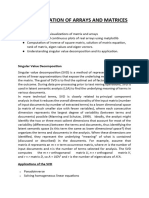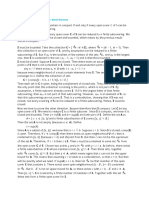0% found this document useful (0 votes)
56 views31 pagesToufik - Linear and Graph LAB
This document contains summaries of various graph algorithms and matrix operations in Python including:
1. Singular Value Decomposition (SVD) decomposes a matrix into three component matrices.
2. Gram-Schmidt process orthonormalizes a set of vectors.
3. Matrix multiplication examples showing how to multiply two matrices together in Python.
4. Eigenvalue and eigenvector examples demonstrating how to compute the eigenvalues and eigenvectors of a matrix.
The document provides code examples and outputs for implementing these algorithms in Python using libraries like NumPy.
Uploaded by
Toufik HossainCopyright
© © All Rights Reserved
We take content rights seriously. If you suspect this is your content, claim it here.
Available Formats
Download as DOCX, PDF, TXT or read online on Scribd
0% found this document useful (0 votes)
56 views31 pagesToufik - Linear and Graph LAB
This document contains summaries of various graph algorithms and matrix operations in Python including:
1. Singular Value Decomposition (SVD) decomposes a matrix into three component matrices.
2. Gram-Schmidt process orthonormalizes a set of vectors.
3. Matrix multiplication examples showing how to multiply two matrices together in Python.
4. Eigenvalue and eigenvector examples demonstrating how to compute the eigenvalues and eigenvectors of a matrix.
The document provides code examples and outputs for implementing these algorithms in Python using libraries like NumPy.
Uploaded by
Toufik HossainCopyright
© © All Rights Reserved
We take content rights seriously. If you suspect this is your content, claim it here.
Available Formats
Download as DOCX, PDF, TXT or read online on Scribd
/ 31

























































































